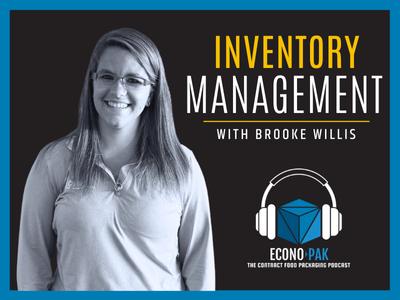Inventory Management in Co-Packing with Brooke Willis
Brooke Willis is an integral part of the Econo-Pak team, known for her dedication and deep understanding of inventory management.
With six years of experience under her belt, Brooke has progressed from data entry to managing inventory processes that keep our operations running smoothly.

Dive into our podcast transcript below as Brooke discusses her path to success, the challenges she’s overcome, and the strategies she uses to ensure seamless coordination across departments.
Brooke's career journey at Econo-Pak
Sarah Richter: Welcome to the Econo-Pak Contract Food Packaging podcast. Today we’re here with Brooke, our inventory manager.
Mike Mead: Hey, Brooke.
Brooke Willis: Hi.
Mike Mead: Thanks for joining us.
Brooke Willis: Yeah, thanks for having me.
Mike Mead: Great.
Sarah Richter: So you have been here for a while, right?
Brooke Willis: Yeah.
Sarah Richter: You want to talk through your journey?
Brooke Willis: So I’ve been here for six years. I started right out of high school. I started in the shipping and receiving department as data entry, then slowly moved my way up here into the front office. About six months after I started here I was doing data entry, kind of helping out with customer service here and there. And then eventually I ended up moving up to customer service, and then after that, inventory manager. So yeah, I’ve been through a lot of different offices, helped out with a lot of different aspects, and I think it helps me a lot that I started in shipping because I learned from where it comes in all the way through to where it goes out.
Mike Mead: Yeah, absolutely.
Brooke Willis: Yeah. It’s been a great experience
Mike Mead: And I know that from working on our scanning project and putting the scanning systems in place, you’ve been a big part of that whole entire project and how you started in the company and then to where you are today, really that’s what that system is meant to handle is to have all that knowledge base.
Brooke Willis: Yeah. It’s awesome.
Mike Mead: Yeah. Definitely.
Sarah Richter: Yeah. We were joking before that you’re our go-to resource for literally anything.
Brooke Willis: Yeah.
Coordinating multiple departments for client projects
Sarah Richter: So talk to us a little bit about how you integrate all of the departments for a seamless process for projects.
Brooke Willis: Spreadsheets are everything, and I also use my Outlook calendar. Everything is on there to make sure I can stay on top of everything. I write little notes. I have sticky notes all over my desk that tell me what I need to do next, and I just cross it off as I go.
Mike Mead: Yeah.
Brooke Willis: Yeah, so that helps me a lot.
Sarah Richter: So what does a day in the life look like for you?
Brooke Willis: In the mornings, it’s really just copying the production paperwork so that way I can give it out to everyone that needs a copy for whatever part they do. I enter it into my own spreadsheets for the customers that I handle. And then I also do a couple different spreadsheets for the warehouse, with their new wrapping system. I help with that. Let’s see. Emails like crazy all day long.
Mike Mead: Communication is everything, right?
Brooke Willis: Yeah. Yeah. I do a lot of different analysis with scrap and just to see how different things are running. If we see higher scrap or lower scrap, that’s a big part of my job.
Mike Mead: Yeah, managing that.
Brooke Willis: Yes, yeah.
Mike Mead: So we want to manage the materials for the clients,
Brooke Willis: Yeah.
Mike Mead: … manage the raw materials.
Brooke Willis: Making sure we have everything here for the production schedule, and if we don’t, we need to get it, asking the right people with where it needs to come from.
Mike Mead: Yeah. I was so impressed when I joined the organization, getting to work with you and seeing all the different departments that you are responsible to integrate with. Like you said, managing the inventory. But probably the biggest part would just be the communication and setting up-
Brooke Willis: Yes.
Mike Mead: … everybody for success. So that’s setting up the client, sending the materials in, making sure that our scheduling team, our production team understands what is going to happen and how we’re going to use those materials, and then monitoring those materials-
Brooke Willis: Yeah.
Mike Mead: … is probably one of the biggest things, right?
Brooke Willis: Yeah.
Mike Mead: Monitoring our usage of those materials and communicating that information to our clients, setting them up for success.
Brooke Willis: Yeah. Yeah. Also, making sure that our system is right with pricing and inventories and everything. Constantly analyzing all that.
Mike Mead: In the way that you organize your data, like your spreadsheets and-
Brooke Willis: Yeah, spreadsheets, yeah. Everything is in a spreadsheet for me, formulas and everything. So that way if something pops up in red, I’m like, “Okay, I need to figure out why.” And I pull all the production paperwork and see where the issue is. If maybe there’s a math error or something, that’s an easy fix, or maybe we just really don’t have it and we need to contact the customer and say, “Can you help us and get it here?”
Mike Mead: Yeah. I’m a big fan of spreadsheets. I love that. And looking at yours has been inspiring. I love the way the colors change with our negatives.
Brooke Willis: Yes.
Mike Mead: It really shows how organized we can be,
Brooke Willis: Yes.
Mike Mead: … and it is important. We have a big system here, so we use our ERP system to manage the materials across the board with everybody, but I think it’s very resourceful to have spreadsheets as well,
Brooke Willis: Yes.
Mike Mead: … and then really dial into your specific need and what you’re going to do.
Brooke Willis: Yeah. Yep.
Managing BOM and procurement for co-packing
Mike Mead: I know you have a big part of managing our materials, managing our inventory for not only internal, but also with our customers. And that really starts with setting up a proper BOM (bill of materials) for our clients. Every product runs very differently in our systems, and you have to work with the client, you have to work with our team internally, and having an internal procurement team as well that’s purchasing some material, some materials are coming in from our customers. So there’s a lot of different areas. How do you go about setting that up for success and managing that?
Brooke Willis: So I usually get a copy of what their BOM internally looks like, the customer’s internal BOM looks like, and I just analyze it to make sure, okay, there’s eight bags per case.
Mike Mead: Yeah.
Brooke Willis: And then I just make sure, okay, this BOM should have eight-plus whatever their allowable scrap is, and then however many pounds per case of product just to make sure that everything winds up with what they’re giving me and what we have. And there has also been times where I’ve found that, “Oh, this doesn’t look right,” and I’ve mentioned it, and they’re like, “Oh yeah, it’s supposed to be this and not that.”
Mike Mead: Well, so you’re helping them improve their systems-
Brooke Willis: Yeah.
Mike Mead: … to work better with us.
Brooke Willis: Yeah.
Mike Mead: That’s really cool.
Sarah Richter: Awesome.
Mike Mead: We had a great interview with our procurement team, talking about how we buy materials and that whole process. When it comes to what you’re doing, do you ever find that there’s opportunities our clients are sending in materials and maybe there’s an opportunity for us maybe to manage those a little bit better and work with our procurement team?
Brooke Willis: Yeah. So I actually have had customers ask me before if there was the chance for having our procurement team source different things for them. So I would lead them to the proper person and start the conversation, and then they would take it from there.
Mike Mead: Yeah. I’m sure that’s more of that turnkey solution-
Brooke Willis: Yeah.
Mike Mead: … that we’ve talked about in a few episodes now. And I could see the value that having us manage that for them because we’re running the production schedule.
Brooke Willis: Yeah.
Mike Mead: So that’s really cool.
Brooke Willis: And it makes it easier sometimes because we can get things a little faster than they might be able to.
Mike Mead: Yeah.
Brooke Willis: So that helps us start production even sooner.
Mike Mead: And they don’t have to manage the communication of when certain materials-
Brooke Willis: Yes, yeah.
Mike Mead: … arrive or anything because we’re handling all that now.
Brooke Willis: We know when its coming, yeah.
Sarah Richter: Yeah.
Mike Mead: And we can build it into the schedule for them, et cetera.
Brooke Willis: And we can reach out directly and ask when it’s coming.
Mike Mead: Yeah. That’s cool. And your department also crosses into another department, which is quality and working with our quality team as you’re managing these materials and managing that aspect of loading the system. Our quality team plays a big part in all the departments. And how do you go about working with quality when it comes to managing the materials?
Brooke Willis: So certain paperwork that we fill out when we’re onboarding a new customer, we review directly with the quality team, so that way we can make sure that our BOM also matches all of their documents, so that way they’re giving their quality team and the production team the right information to make sure that we have successful production.
Mike Mead: Okay, yeah, because that makes a lot of sense from talking with our customer service team as well with how we build out the work instructions and then having that, so that’s a whole nother layer of making sure we’re set for success. That’s awesome. Cool.
Brooke's family life
Sarah Richter: Awesome. Well, not only is Brooke doing the most at work, but she’s also doing the most outside of work, so.
Brooke Willis: Yes.
Sarah Richter: You want to talk about that?
Brooke Willis: Yeah. So we have the two little ones. We have Lacey and Luke, and then we have a bunch of farm animals, and we’re always busy, whether we’re tractor pulling or camping or just spending time with family is a big thing.
Mike Mead: Yeah.
Sarah Richter: That’s awesome.
Mike Mead: So family’s everything outside of work.
Brooke Willis: Yes. Oh yeah. Absolutely.
Mike Mead: I’m sure the little ones keep you busy.
Brooke Willis: Yes, yes. Yes, that’s for sure.
Mike Mead: So, great.
Sarah Richter: Yeah. Cool.
Mike Mead: Awesome.
Sarah Richter: Well, thanks so much, Brooke. We appreciate having you on.
Brooke Willis: Thank you.
Mike Mead: That was awesome. Thank you.
Brooke Willis: Yeah, thank you.
Let's start scaling.
Is your demand outpacing your ability to package your own product? Then consider outsourcing with Econo-Pak.
With over 40 years of experience working with both small brands and Fortune 500 companies, we are capable of handling your specific dry food product.
Get in touch with our team for a fixed-price quote for your project.




